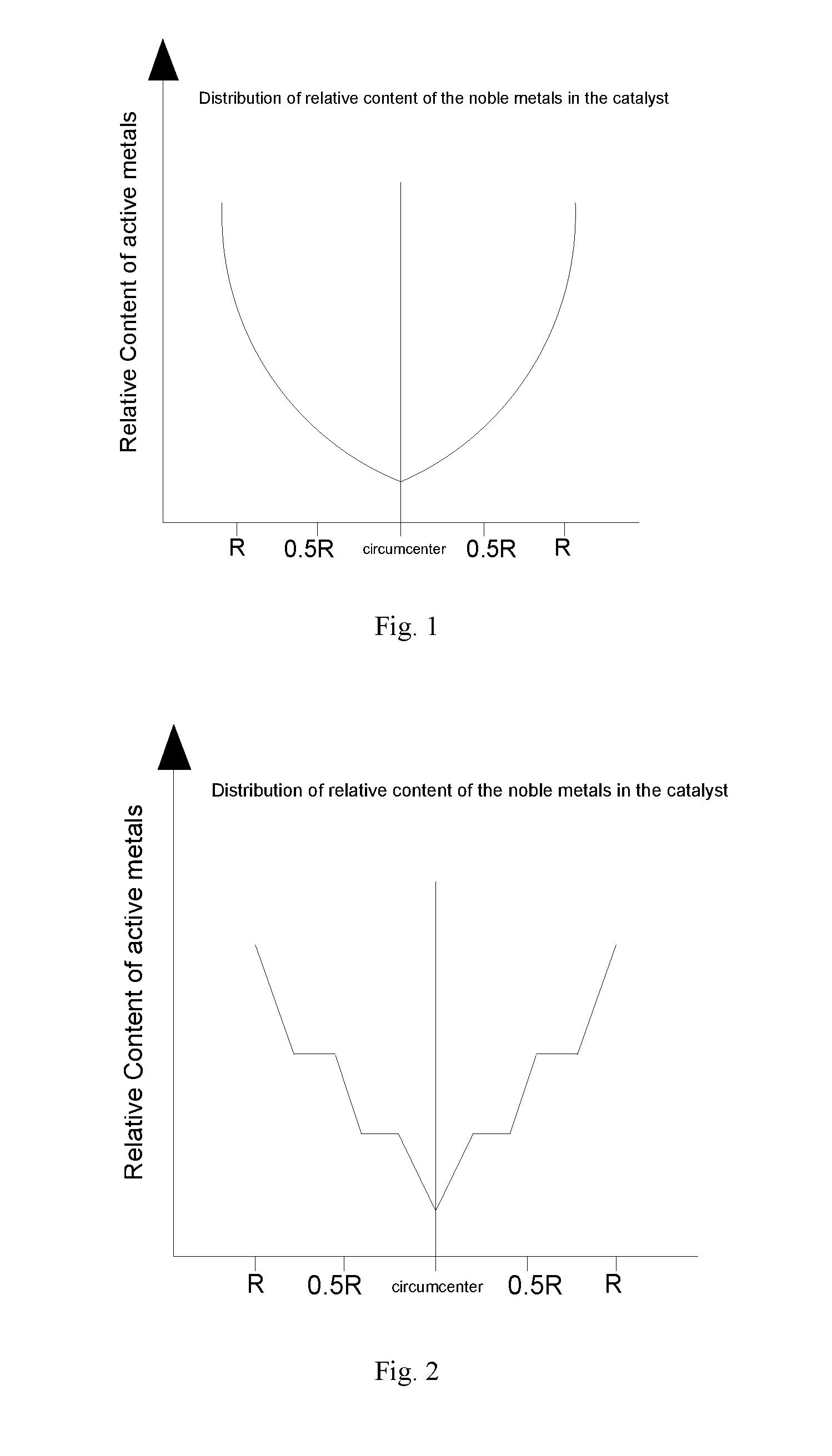Method for Preparing Noble Metal Hydrogenation Catalyst, Noble Metal Hydrogenation Catalyst and Use Thereof
a hydrogenation catalyst and noble metal technology, applied in the field of noble metal hydrogenation catalyst and preparation method, can solve the problems of poor aromatic ring-opening capability, insufficient hydrogenation isomerization performance of the catalyst, and the hydrolysis technology is now facing tough challenges. , to achieve the effect of good hydrogenation activity, excellent hydroisomerization performance and high stability
- Summary
- Abstract
- Description
- Claims
- Application Information
AI Technical Summary
Benefits of technology
Problems solved by technology
Method used
Image
Examples
example 1
[0058]A catalyst was prepared by incipient impregnation. Inorganic porous materials comprising 45 wt % of Al2O3, 20 wt % of Al2O3—SiO2, 10 wt % of SiO2, and 20 wt % TiO2 in a carrier were mechanically kneaded with 5 wt % of EU-1 molecular sieve into a carrier with a water absorption of 0.60 ml / g.
[0059]200 g of the carrier was weighed and sprayed and impregnated with 50 ml of an impregnation solution containing PtCl2 at a concentration of 0.05 wt %. During the spray impregnation, 70 ml of an impregnation solution containing 0.16 wt % PtCl2in diluted hydrochloric acid was dropped into the previous impregnation solution at a constant speed over 30 minutes. The catalyst was homogenized in the spray impregnation apparatus for 10 minutes, dried at 90° C. for 10 hours, and then calcinated at 600° C. for 3 hours to afford catalyst A-1 , wherein the mass fraction of Pt contained in the prepared catalyst A-1 was 0.05% (on catalyst mass basis).
example 2
[0060]A catalyst was prepared by incipient impregnation. Inorganic porous materials comprising 20 wt % of Al2O3, 20 wt % of Al2O3—ZrO2, 10 wt % of TiO2, and 10 wt % Al2O3—TiO2 in a carrier were mechanically kneaded with 40 wt % of ITQ-13 and ZSM-23 molecular sieves into a carrier with a water absorption of 0.7 ml / g.
[0061]200 g of the carrier was weighed and sprayed and impregnated with 50 ml of an impregnation solution containing PtCl2 and PdCl2 at a concentration of 0.2 wt %. During the spray impregnation, 90 ml of an impregnation solution containing 0.7 wt % PtCl2 and PdCl2 in diluted hydrochloric acid was dropped into the previous impregnation solution at a constant speed over 30 minutes. The catalyst was homogenized in the spray impregnation apparatus for 3 hours, dried at 140° C. for 3 hours, and then calcinated at 450° C. for 10 hours to afford catalyst A-2, wherein the mass fraction of Pt and Pd contained in the prepared catalyst A-2 was 0.2% (on catalyst mass basis).
example 3
[0062]A catalyst was prepared by incipient impregnation. Inorganic porous materials comprising 10 wt % of Al2O3—SiO2 and 10 wt % ZrO2 in a carrier were mechanically kneaded with 40 wt % of MCM-22 and 40 wt % of ZSM-23 molecular sieves into a carrier with a water absorption of 0.75 ml / g.
[0063]200 g of the carrier was weighed and sprayed and impregnated with 50 ml of an impregnation solution containing PtCl2 and PdCl2 at a concentration of 0.4 wt %. During the spray impregnation, 100 ml of an impregnation solution containing 1.6 wt % PtCl2 and PdCl2 in diluted hydrochloric acid was dropped into the previous impregnation solution at a constant speed over 30 minutes. The catalyst was homogenized in the spray impregnation apparatus for 2 hours, dried at 100° C. for 6 hours, and then calcinated at 550° C. for 6 hours to afford catalyst A-3, wherein the mass fraction of Pt and Pd contained in the prepared catalyst A-3 was 0.6% (on catalyst mass basis).
PUM
| Property | Measurement | Unit |
|---|---|---|
| mass fraction | aaaaa | aaaaa |
| mass fraction | aaaaa | aaaaa |
| mass fraction | aaaaa | aaaaa |
Abstract
Description
Claims
Application Information
 Login to View More
Login to View More - R&D
- Intellectual Property
- Life Sciences
- Materials
- Tech Scout
- Unparalleled Data Quality
- Higher Quality Content
- 60% Fewer Hallucinations
Browse by: Latest US Patents, China's latest patents, Technical Efficacy Thesaurus, Application Domain, Technology Topic, Popular Technical Reports.
© 2025 PatSnap. All rights reserved.Legal|Privacy policy|Modern Slavery Act Transparency Statement|Sitemap|About US| Contact US: help@patsnap.com

